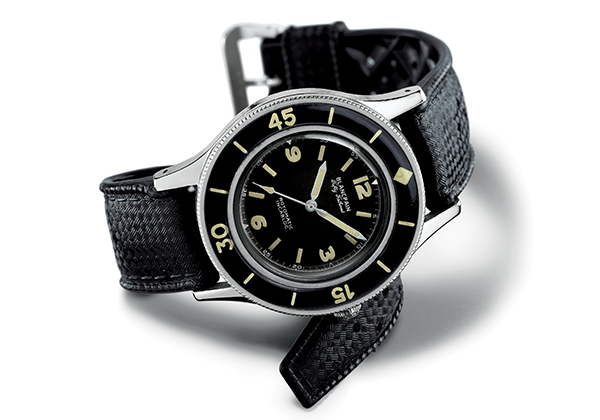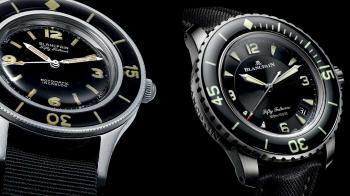It is one of those icons that seem to have been around forever. And that’s true, but it’s also false. The Fifty Fathoms has evolved considerably over the years. It was born in 1953, the same year as a certain Rolex Submariner (1953), and well after Panerai (Radiomir, 1938) but before other divers such as those by Doxa (Sub, 1964) and Seiko (Prospex, 1968).
Hand-to-hand combat
For the purposes of comparison, let’s look at two extremes. First, we have the original Fifty Fathoms from 1953, of which Blancpain holds just one example in its museum at the Ferme du Brassus. And in the opposite corner, there’s the Fifty Fathoms “Nageurs de combat”, one of the new models released for 2019. Almost 70 years separate these two pieces, a period of time that highlights the differences and, perhaps paradoxically, their similarities.

Movement in motion
As you might expect, most of the changes are in the movement. The original model was fitted with the R.570 calibre, sometimes also called the MILSPEC R 570. The “MILSPEC” designation refers to the military specifications, mainly anti-magnetism, that the Fifty Fathoms had to meet at the end of the 1950s, in order to be adopted by naval forces. The first Fifty Fathoms of 1953 already had an automatic movement, and that has always been one of its standout features. Jean-Jacques Fiechter, who was Blancpain’s CEO at the time (1950-1980), believed that an automatic winding mechanism would reduce the wear on the crown and gaskets that could be caused by manual winding.
The current movement is the calibre 1315, which is the movement of reference for the vast majority of contemporary three-handed Fifty Fathoms. It also provides a date. It promises a power reserve three times that of the original Fifty Fathoms: up from 38 hours in 1953 to 120 hours today. This calibre was introduced in 2007; from the outset it carried many of the typical features of its time, and as many differences from its predecessor, the Calibre R.570.
Good vibrations
These differences include the reference frequency: 18,000 vibrations per hour for the original, against 28,800 vph for the current model. The former is a historical frequency that was common from the beginning of the 20th century up to the 1960s, when it was gradually replaced, first with the 3 Hz frequency (21,600 vph) and then 4 Hz (28,800 vph). The low frequency was said to handle shocks better, although the laws of mathematics mean it was inevitably less precise than contemporary rates. It has virtually disappeared from modern production, with the exception of Raketa in Russia, which continues to use this frequency for all its models.
Uncaged
The escapement mechanism (Swiss anchor escapement) remained unchanged between 1953 and 2019, although the materials have been updated. Originally in steel, it is now made of silicon. The main consequence of this is that the 2019 Fifty Fathoms is amagnetic (intrinsically unaffected by magnetism), while the 1953 model was anti-magnetic (susceptible to magnetic fields, but protected from them). The current model has therefore been able to dispense with the imposing Faraday cage that protected the movement back in the day, significantly reducing the thickness of the case.
Aesthetic statement
The aesthetic fundamentals of the Fifty Fathoms have remained remarkably stable: black dial, black bezel, black strap, large luminescent markers. It’s a simple but utterly timeless recipe, and one that has helped the timepiece to traverse the decades. When something’s not in fashion, it can never be out of it. The Fifty Fathoms has always placed the accent on minimalism and thus, incidentally, efficiency, with a remarkably legible dial. The same goes for the case, which is still made of steel.

Invisible details
The Fifty Fathoms nevertheless conceals some sensitive, albeit invisible, modifications. The first concerns the bezel. In 1953 it was bi-directional, but with a locking mechanism. The 2019 version is unidirectional. In fact, the features of diving watches were standardised by the ISO a long time ago. The ISO 6425 standard, which is still in effect, dates back to 1982. It was revised in 1984 and again in 1996. The version 60.60 was published on 17 October 2018, and that’s the standard that all watches have to meet in order to be categorised as diving watches. As this standard went through various revisions, some features were standardised. These include luminescence, water resistance and the bezel, which today must imperatively be unidirectional. In the meantime, Blancpain took the opportunity to change the bezel material from bakelite to sapphire, and the crystal from hesalite to sapphire, in a case that has expanded from 42 to 45 mm.
Price evolution
The 1953 model has become increasingly difficult to find, and now changes hands for five or six figures. A model dating from the late 1950s can fetch 30,000 dollars. The 2019 version, reference 5015 12B30 NABA, currently costs CHF 14,700. The comparison is merely indicative. It’s still the same collection but, with 66 years separating them, is it still the same watch?






